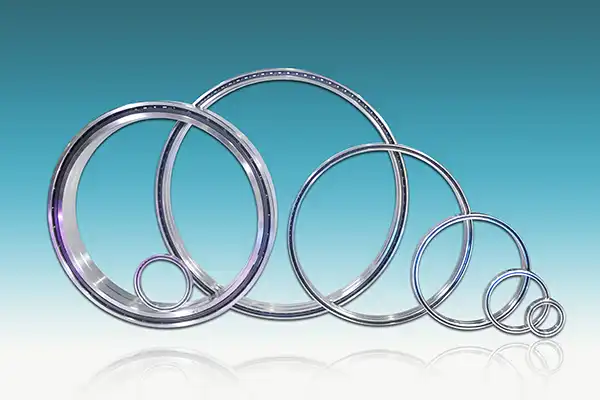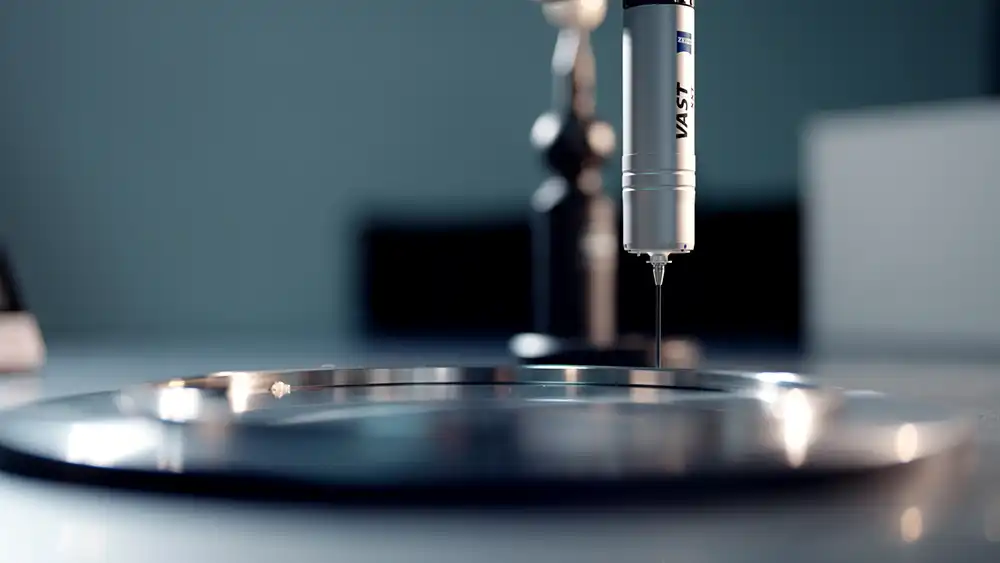What is the Load Capacity of Metric Thin Section Bearings?
Metric thin section bearings are specialized components designed to provide high precision and performance in applications where space is limited. These bearings are characterized by their thin cross-section and lightweight construction, making them ideal for use in various industries, including robotics, aerospace, and medical equipment. One of the most critical factors to consider when selecting a metric thin section bearing is its load capacity, which determines the maximum weight or force the bearing can support without compromising its performance or lifespan.

How do metric thin section bearings differ from standard bearings?
Metric thin section bearings are a unique class of bearings that offer several distinct advantages over standard bearings. The primary difference lies in their design and construction. As the name suggests, thin section bearings have a much thinner cross-section compared to standard bearings of similar bore size. This slim profile allows them to be used in applications where space is at a premium, without sacrificing performance or reliability.
The construction of metric thin section bearings involves precision engineering to ensure that they can maintain their structural integrity and performance despite their reduced size. They are typically made from high-quality materials such as stainless steel or chrome steel, which provide excellent durability and corrosion resistance. The races and rolling elements of thin section bearings are manufactured to tight tolerances, ensuring smooth operation and minimal friction.
One of the key advantages of metric thin section bearings is their weight savings. Due to their reduced cross-section, they are significantly lighter than standard bearings with the same bore size. This makes them ideal for applications where weight reduction is critical, such as in aerospace or high-speed machinery. The reduced weight also contributes to lower inertia, allowing for faster acceleration and deceleration in dynamic applications.
Another notable difference is the increased flexibility of thin section bearings. Their slim profile allows for a certain degree of elasticity, which can be beneficial in applications where slight misalignments or deflections may occur. This flexibility can help distribute loads more evenly and reduce stress concentrations, potentially extending the bearing's lifespan.
However, it's important to note that the reduced cross-section of thin section bearings does come with some trade-offs. While they excel in many applications, their load capacity is generally lower than that of standard bearings of the same bore size. This means that careful consideration must be given to the specific load requirements of the application when selecting a thin section bearing.
Despite this limitation, metric thin section bearings offer unique advantages in terms of space-saving, weight reduction, and precision performance. Their ability to operate in confined spaces while maintaining high accuracy makes them invaluable in industries such as robotics, semiconductor manufacturing, and medical devices, where compact design and precise motion control are essential.

What factors affect the load capacity of metric thin section bearings?
The load capacity of metric thin section bearings is influenced by several key factors, each playing a crucial role in determining the bearing's ability to withstand applied forces. Understanding these factors is essential for engineers and designers to select the most appropriate bearing for their specific application.
1. Material composition: The material from which the bearing is manufactured significantly impacts its load capacity. High-quality materials such as AISI 52100 chrome steel or 440C stainless steel are commonly used due to their excellent hardness, wear resistance, and fatigue strength. Advanced materials like ceramic or hybrid bearings (combining steel races with ceramic balls) can offer even higher load capacities and improved performance in certain applications.
2. Bearing size and geometry: While thin section bearings are designed to be compact, their overall size still plays a role in load capacity. Larger bearings generally have higher load capacities due to increased contact area between the rolling elements and races. The cross-section thickness, while reduced compared to standard bearings, also affects load capacity. Bearings with slightly thicker cross-sections within the thin section range may offer higher load capacities.
3. Number and size of rolling elements: The quantity and dimensions of the rolling elements (balls or rollers) directly influence load capacity. More rolling elements or larger elements can distribute the load over a greater area, increasing the bearing's overall capacity. However, this must be balanced with the need to maintain the thin profile characteristic of these bearings.
4. Contact angle: For angular contact thin section bearings, the contact angle between the rolling elements and the raceways affects load capacity. Higher contact angles generally provide better axial load capacity but may reduce radial load capacity. The optimal contact angle depends on the specific application requirements.
5. Raceway design: The design of the bearing's raceways, including their curvature and surface finish, impacts load distribution and capacity. Optimized raceway geometries can enhance load capacity by ensuring even distribution of stresses across the bearing.
Understanding these factors allows engineers to make informed decisions when selecting metric thin section bearings for their applications. It's often necessary to balance various requirements, such as load capacity, speed, precision, and space constraints, to find the optimal bearing solution. In some cases, custom-designed thin section bearings may be required to meet specific load capacity requirements while maintaining the desired compact form factor.
How can you maximize the load capacity of metric thin section bearings in your application?
Maximizing the load capacity of metric thin section bearings is crucial for ensuring optimal performance and longevity in demanding applications. While these bearings are designed to offer high precision in compact spaces, there are several strategies that engineers and designers can employ to enhance their load-bearing capabilities without compromising their slim profile. Here are comprehensive approaches to maximize the load capacity of metric thin section bearings in various applications:
1. Proper bearing selection:
The first step in maximizing load capacity is selecting the right bearing for your specific application. This involves a thorough analysis of the expected loads, both in magnitude and direction (radial, axial, or combined). Consider using angular contact thin section bearings for applications with significant axial loads, as they can handle both radial and axial forces effectively. For purely radial loads, radial contact bearings may be more suitable. Always choose a bearing with a load rating that exceeds your application's requirements, factoring in safety margins and potential peak loads.
2. Optimize bearing arrangement:
In many applications, multiple thin section bearings are used together. The arrangement of these bearings can significantly impact the overall load capacity of the system. Common arrangements include:
- Back-to-back: Provides good rigidity and can handle moment loads effectively.
- Face-to-face: Offers flexibility to accommodate misalignment but with less moment load capacity.
- Tandem: Increases axial load capacity in one direction.
- Duplex pairs: Preloaded pairs that increase stiffness and precision.
By carefully considering the load distribution in your application, you can select the most appropriate arrangement to maximize load capacity and performance.
3. Implement proper preloading:
Preloading is a technique used to eliminate internal clearances within the bearing, increasing stiffness and precision. While excessive preload can reduce load capacity by adding internal stresses, a correctly applied preload can actually enhance the bearing's ability to handle external loads. The optimal preload depends on the application requirements, operating conditions, and bearing design. Work closely with bearing manufacturers or consult engineering guidelines to determine the appropriate preload for your specific use case.
4. Enhance lubrication strategies:
Proper lubrication is critical for maximizing load capacity and extending bearing life. For thin section bearings, consider:
- Using high-quality lubricants specifically designed for precision bearings.
- Implementing oil-air lubrication systems for high-speed applications to ensure adequate lubrication while minimizing heat generation.
- Exploring solid lubricant coatings for extreme environments where traditional lubricants may not be suitable.
Effective lubrication reduces friction, dissipates heat, and protects bearing surfaces, all of which contribute to maintaining maximum load capacity over time.
5. Control operating environment:
The environment in which the bearing operates can significantly impact its load capacity. To maximize performance:
- Implement robust sealing solutions to prevent contamination, which can lead to premature wear and reduced load capacity.
- Control temperature through proper heat dissipation methods, as excessive heat can reduce material strength and lubricant effectiveness.
- Minimize exposure to corrosive elements that could degrade bearing materials and reduce load capacity over time.
By implementing these strategies, engineers can significantly enhance the load-bearing capabilities of metric thin section bearings in their applications. It's important to note that maximizing load capacity often involves balancing multiple factors and may require trade-offs in other areas of performance. Always consult with bearing manufacturers and conduct thorough testing to ensure that any modifications or optimizations do not compromise the overall reliability and safety of the system.

In conclusion, while metric thin section bearings are designed for space-constrained applications, there are numerous ways to maximize their load capacity. By carefully considering bearing selection, arrangement, lubrication, environmental controls, and advanced materials, engineers can push the boundaries of what these compact bearings can achieve. As technology continues to advance, we can expect further innovations in thin section bearing design and materials, potentially offering even higher load capacities in the future.
References
1. SKF Group. (2023). Thin section bearings.
2. Kaydon Bearings. (2022). Thin Section Bearings Catalog.
3. NSK Americas. (2021). Thin-Section Bearings.
4. Schaeffler Group. (2023). Thin section bearings.
5. NTN Bearing Corporation. (2022). Thin-Section Bearings.
6. American Bearing Manufacturers Association. (2023). Load Ratings & Bearing Life.
7. Timken Company. (2023). Thin Section Bearings.
8. JTEKT Corporation. (2022). Thin-Section Ball Bearings.
9. IKO International. (2023). Thin Section Bearings.
10. RBC Bearings. (2023). Thin Section Bearings.

